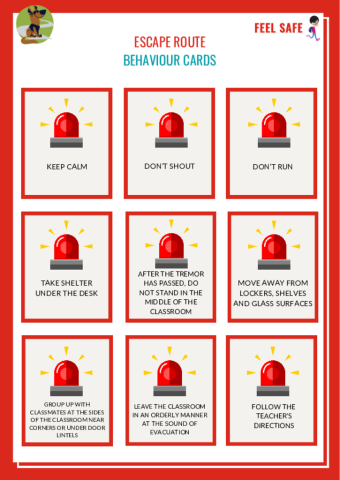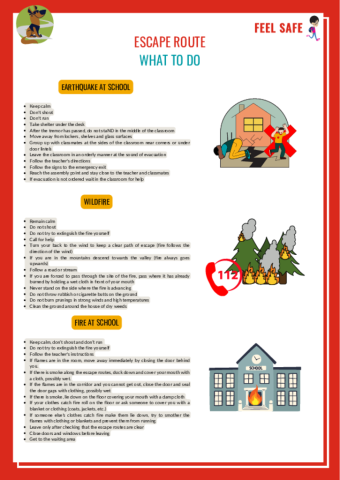Escape Route
Objectives:
- Get to know what to do in case of fire and earthquake
STEP BY STEP
Before starting
The teacher introduces the topic by asking the class:
What is an escape route An obstacle-free route that, together with correct behaviour, allows people to evacuate safely ?
The definition of escape route found in the glossary is then introduced:
Escape route: an unobstructed pathway that, together with correct behaviors, allows for the safe evacuation of people.
Knowing escape routes is essential in an emergency, whether you are in an enclosed place or an open space. Escape routes are always shown in the Evacuation Plan An operational tool through which the operations to be carried out in the event of an emergency must be studied and planned. It includes the route to be followed in the event of an evacuation. At school it is called the School Evacuation Plan. .
What to do?
The teacher explains that every public place has an evacuation plan An operational tool through which the operations to be carried out in the event of an emergency must be studied and planned. It includes the route to be followed in the event of an evacuation. At school it is called the School Evacuation Plan. where all the directions to follow in case of an emergency are contained. When entering a public place, it is therefore a good idea to consult the emergency plan. Knowing the escape route An obstacle-free route that, together with correct behaviour, allows people to evacuate safely , however, does not necessarily mean being safe. In fact, it is not enough to know how to recognize the signs; the difference will be made by the behavior of the individual person who, for example, during an earthquake Sudden ground shaking resulting from movements of the earth’s crust may decide to follow the sign indicating the emergency exit and take the safe route or use the elevator to leave a building.
At this point the teacher can ask the class the following questions:
Do you know what to do in case of an earthquake or fire? In your opinion, are the behaviors to be implemented the same for the two scenarios? Are there differences in the behaviors to be implemented if we are in a building or outdoors?
The right action at the right time
After printing and cutting out the Behavior Cards (see attached " Escape Route An obstacle-free route that, together with correct behaviour, allows people to evacuate safely - Behavior Cards" below), the teacher places the uncovered cards on the teacher's desk and explains that each card shows a correct behavior to follow in case of fire or earthquake Sudden ground shaking resulting from movements of the earth’s crust .
At this point, after dividing the class into three groups, the teacher assigns each group a scenario from the following:
Fire at school - Fire in the open air - Earthquake at school
In turn, one member of each group will be called to the desk and will have to choose a behavior card that he or she thinks is correct for the scenario assigned to the group. At the end, each card should have been assigned. Each group will have a few minutes to reorder their cards and then share with the class what needs to be done first and what needs to be done next in their given scenario.
Concluding thoughts
Correct emergency behavior is also often the same in different situations. For example, whether there has been an
earthquake
Sudden ground shaking resulting from movements of the earth’s crust
, a flood or a spill of hazardous substances from an industrial plant, it is always correct to listen to the directions given by the personnel handling the emergency.
The teacher with the help of an informative sheet (see attached "
Escape Route
An obstacle-free route that, together with correct behaviour, allows people to evacuate safely
- What to do" below) can reflect with the class on which behaviors among those on the cards are correct to take in scenarios other than earthquake and fire, and how taking the wrong behaviors can make it difficult to travel an escape route.


Add new comment